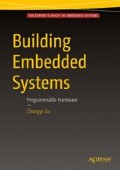Abstract
This chapter covers some miscellaneous hardware topics that are important to embedded systems, such as power-on resets, switch de-bouncing, power management, managing displays, and using touchscreens.
Access this chapter
Tax calculation will be finalised at checkout
Purchases are for personal use only
Notes
- 1.
In CMOS circuit, there are parasite BJTs formed by p well, n well, and the substrate. When these parasite BJTs are turned on by ESD or incorrect power-on sequence, a short circuit will be created. The creation of such short circuit is called latch-up. IC designers would usually put guard rings to prevent latch-up, but only to some extent.
- 2.
As a trade-off between brightness, contrast, and dim environment, some LCDs called transflective display use both reflection and backlighting. Under sunlight, the backlight can be turned off, but it can be turned back on when the environment is dim. In this way, a transflective LCD can be viewed in both direct sunlight and lowlighting conditions.
- 3.
- 4.
Note that TN and STN are merely referring to the liquid crystal cell structure while the passive or active matrixes mainly refer to the way how electrical fields are applied and kept. For STN, it is commonly used on passive matrix. But for TN, there are also TN-active-matrix LCDs being manufactured.
- 5.
I’m not sure if there is an industry standard on those tech terms. But my impression is that LCD modules are often more advanced than LCD panels.
- 6.
This is not always true, as sensors can also be integrated into the LCD display, such as is the case with the in-cell technology.
- 7.
This is not always true, though. With some extra effort, certain gestures can be recognized as well on resistive touch screens, as exemplified in Ref [24].
References
AN2790, TFT LCD interfacing with the high-density STM32F10xxx FSMC, Rev 2, STMicroelectronics, September, 2008
Using Schmitt Triggers for Low Slew-Rate Input, Application Note AC161, Actel Corporation, November, 2002
MAX6323/MAX6324 μP Supervisory Circuits with Windowed (Min/Max) Watchdog and Manual Reset, Maxim Integrated Products, Inc. 2010
“A Guide to Debouncing, or, How to Debounce a Contact in Two Easy Pages” (Rev 4). Jack Ganssle, March, 2014 ( http://www.ganssle.com/debouncing.htm )
SC70/μDFN, Single/Dual Low-Voltage, Low-Power μP Reset Circuits, Maxim Integrated Products, 2012
Liquid Crystal Display (LCD) Passive Matrix and Active Matrix Addressing, Application Note (AN-002), Hitachi Europe Ltd, August, 2004
Fundamentals of Liquid Crystal Displays—How They Work and What They Do, Fujitsu Microelectronics American, Inc.
Liquid Crystal Display Drivers, Techniques and Circuits, Dr. David J.R. Cristaldi, Prof Salvatore Pennisi and Dr Francesco Pulvirenti, Springer International Publishing AG, 2009
Overview of the theory and construction of TFT display panels, SEQUOIA Technology, Ltd, December, 2003
Driving matrix liquid crystal displays, T N RUCKMONGATHAN, Raman Research Institute, PRAMANA - Journal of Physics, July 1999
Chip-on-Glass LCD Driver Technology, Well-proven Approach from NXP Reduces Medical System Design Costs, NXP July, 2012
AVR065: LCD Driver for the STK502, ATMEL Corporation
GDC130 Product Specification, DALIAN GOOD DISPLAY CO.LTD, March 11, 2008
AN52927, LCD Direct Drive Basics, Geethesh NS, Cypress Semiconductor, May 26, 2009
ATmega169A/PA/329A/PA/3290A/PA/649A/P/6490A/P 8-bit Atmel Microcontroller with 16/32/64KB In-System Programmable Flash DATASHEET, Atmel Corporation, July, 2014
AVR340: Direct Driving of LCD Using General Purpose IO, Atmel Corporation, September, 2007
MSP430xG461x MIXED SIGNAL MICROCONTROLLER, Texas Instruments, March, 2011
A guide to VFD operation, http://www.noritake-itron.com/SubPages/ApplicNotesE/vfdoperapn.htm
HD44780U (LCD-II) (Dot Matrix Liquid Crystal Display Controller/Driver, Hitachi Ltd, 1998
Interfacing a Hitachi HD44780 to a Silicon Laboratories C8051F120, Steve Dombrowski, Rensselaer Polytechnic Institute
Optrex 16207 LCD Controller Core, Altera Quartus II handbook, Vol. 5, Embedded Peripherals
4-Wire and 8-Wire Resistive Touch-Screen Controller Using the MSP430, Neal Brenner, Shawn Sullivan, William Goh, Texas Instruments, November, 2010
AN10675, Interfacing 4-wire and 5-wire resistive touchscreens to the LPC247x, NXP Semiconductors, November, 2008
AD7879 Controller Enables Gesture Recognition on Resistive Touch Screens, Javier Calpe, Italo Medina, Alberto Carbajo, María José Martínez, Analog Dialogue Vol 45 June, 2011
Designing Gestural Interfaces, Touchscreens and Interactive Devices. Dan Saffer, O’Reilly Media, December, 2008
Author information
Authors and Affiliations
Rights and permissions
Copyright information
© 2016 Changyi Gu
About this chapter
Cite this chapter
Gu, C. (2016). De-Bounce, Power Management, and Display. In: Building Embedded Systems. Apress, Berkeley, CA. https://doi.org/10.1007/978-1-4842-1919-5_11
Download citation
DOI: https://doi.org/10.1007/978-1-4842-1919-5_11
Published:
Publisher Name: Apress, Berkeley, CA
Print ISBN: 978-1-4842-1918-8
Online ISBN: 978-1-4842-1919-5
eBook Packages: Professional and Applied ComputingApress Access BooksProfessional and Applied Computing (R0)


